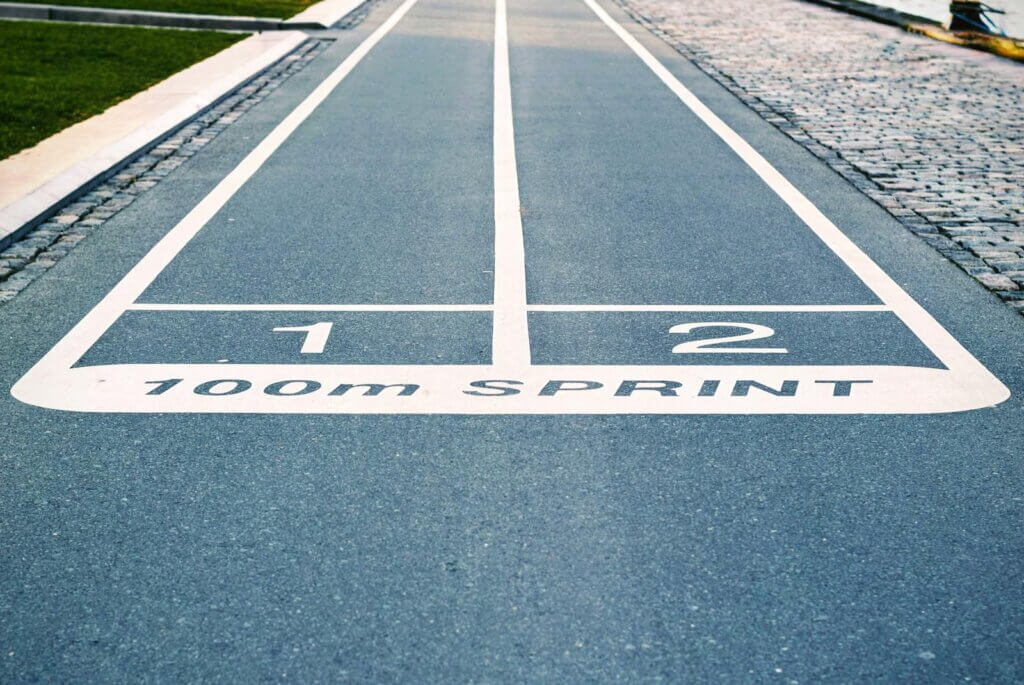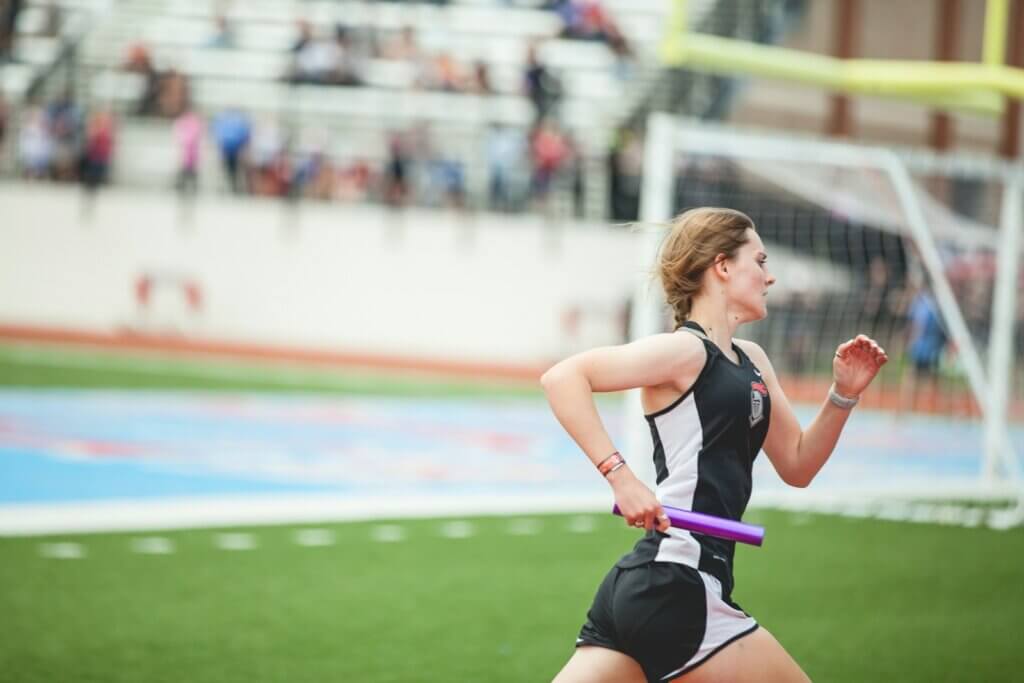Ever pondered over the elusive average 100 meter time? It’s a query that resonates with athletes and enthusiasts alike, prompting a quest for realistic benchmarks.
For sedentary men who do not engage in regular exercise, the average time to complete a 100 meter sprint may fall within the range of 14 to 17 seconds. Sedentary women, under similar circumstances, might typically finish the distance in approximately 16 to 19 seconds.
High school boys typically run a 100 meter sprint in 12 to 14 seconds, while girls usually finish in 13 to 15 seconds, reflecting their athletic engagement.
In this blog post, we’ll unravel the nuances surrounding the average 100 meter time, providing insights applicable to runners of all ages and genders.
Table of Contents
How Long is 100 Meters?

Let’s delve into the dimensions of 100 meters in various units.
In kilometers, it equates to approximately 0.1 kilometers, a relatively short distance. Converting to yards, it spans roughly 109 yards, akin to traversing most of the length of a football field. Breaking it down further, in feet, 100 meters extends to about 328 feet.
Visualize covering the expanse of a football field thrice – a notable distance indeed. While initially seeming manageable, 100 meters holds significance when considering its actual dimensions.
What are the Current 100 Meter World Records?
Let’s explore the pinnacle of speed in the 100 meter dash by examining the current world records.
For men, the record stands at an astonishing 9.58 seconds, established by Usain Bolt, the renowned Jamaican sprinter, in 2009. This remarkable feat highlights the epitome of human swiftness.
On the women’s side, Florence Griffith-Joyner, famously known as Flo-Jo, holds the record with an equally impressive time of 10.49 seconds. These records represent the zenith of athletic achievement, serving as benchmarks for sprinters worldwide.
Average 100 Meter Time By Age and Gender
We’ll now explore the average 100 meter times across different age groups and genders, taking into account various fitness levels. Here, we’ll categorize fitness levels into three tiers: beginner, intermediate, and advanced.
- Beginners are individuals who engage in occasional physical activity or are just starting their fitness journey.
- Intermediates are those who maintain a moderate level of fitness through regular exercise and training.
- Advanced are athletes or individuals who have a high level of fitness due to intense training and dedication.
Average 100 Mile Time : Man
| Age Group | Beginner (s) | Intermediate (s) | Advanced (s) |
|---|---|---|---|
| 15-19 | 15-19 | 13-16 | 11-14 |
| 20-29 | 16-20 | 14-17 | 12-15 |
| 30-39 | 17-21 | 15-18 | 13-16 |
| 40-49 | 18-22 | 16-19 | 14-17 |
Average 100 Mile Time: Woman
| Age Group | Beginner (s) | Intermediate (s) | Advanced (s) |
|---|---|---|---|
| 15-19 | 16-20 | 14-17 | 12-15 |
| 20-29 | 17-21 | 15-18 | 13-16 |
| 30-39 | 18-22 | 16-19 | 14-17 |
| 40-49 | 19-23 | 17-20 | 15-18 |
These tables provide an overview of the estimated average 100 meter times for different age groups and fitness levels.
Average 100 meter time for high school
In high school track and field, the average 100 meter time for boys and girls can vary depending on several factors, including training, genetics, and overall athleticism. Let’s consider a scenario:
For a high school boy who actively participates in track and field, with regular training and moderate athletic ability, an average 100 meter time might fall around 12-14 seconds. This range allows room for improvement as the athlete continues to develop skills and strength over the course of their high school career.
On the other hand, for a high school girl also involved in track and field, her average 100 meter time might typically range from 13-15 seconds. While girls often mature physically earlier than boys, and some may demonstrate exceptional speed, this time frame accounts for a range of abilities and training levels among female high school athletes.
Read: Average 8 mile run time by age
Factors Affecting Your 100 Meter Time

When it comes to sprinting, numerous factors come into play that can impact your 100 meter dash time. Understanding these variables can help you optimize your performance and achieve your best results on the track. Let’s delve deeper into each factor:
1. Fitness Level
Your overall fitness level significantly influences your sprinting ability. Regular cardiovascular exercise, strength training, and agility drills can improve your speed over time.
2. Technique
Proper running technique is crucial for maximising speed and efficiency. Elements such as arm swing, stride length, and foot strike pattern can affect your sprinting mechanics. Practicing proper form through drills and coaching can lead to noticeable improvements in your sprint time.
3. Muscle Strength and Power
Strong leg muscles are essential for generating power during sprinting. Exercises like squats, lunges, and plyometrics can help develop the explosive strength needed for a faster sprint.
4. Starting Technique
The way you initiate your sprint can significantly impact your overall time. A powerful and explosive start is crucial for gaining momentum early in the race. Proper starting technique involves driving off the blocks with force and maintaining a low body position.
5. Environmental Conditions
External factors such as wind speed, temperature, and altitude can affect your sprint performance. A tailwind can provide a slight advantage by pushing you forward, while a headwind can slow you down. Additionally, sprinting at higher altitudes may result in decreased oxygen levels, impacting your endurance and speed.
6. Mental Focus
Your mindset plays a significant role in sprinting performance. Maintaining focus and concentration throughout the race can help you overcome fatigue and push through the finish line. Visualization techniques and positive self-talk can enhance mental toughness and confidence.
7. Race Strategy
Strategic pacing and race tactics can affect your overall sprint time. Knowing when to accelerate, maintain speed, and conserve energy during a race is key to optimizing performance. Developing a race plan based on your strengths and weaknesses can lead to more efficient sprinting.
8. Equipment
The right gear can make a difference in sprinting performance. Properly fitting shoes with good traction and support can enhance your speed and reduce the risk of injury. Lightweight, breathable clothing allows for unrestricted movement and comfort during the race.
By considering and optimising these factors in your training and preparation, you can work towards improving your 100 meter sprint time and reaching your full potential on the track.
What’s A Good 100 Meter Time?
Determining what constitutes a good 100 meter time can vary based on factors like age, gender, and level of competition.

For beginners or those with limited physical activity, a respectable 100 meter time could range from 15 to 20 seconds. This range acknowledges that not everyone starts with the same baseline fitness level and allows for progress over time with consistent training.
As individuals become more active and adopt healthier lifestyles, their 100 meter times may improve. For intermediate-level runners, achieving a time between 13 to 16 seconds could be considered good progress. This improvement reflects a commitment to regular exercise and an increase in overall fitness.
Even for those facing health challenges or starting from a sedentary lifestyle, working towards a time of around 12 to 15 seconds could signify significant achievement and improved health outcomes. It’s essential to recognise and celebrate progress, regardless of where you start on your fitness journey.
How To Improve Your 100 Meter Time?
Improving your 100 meter time requires a targeted approach to training and technique refinement. Here are five practical tips to help you get faster:
1. Consistent Sprint-Specific Workouts
Dedicate at least three to four sessions per week to sprint-specific exercises. Focus on drills that emphasize speed, power, and agility.
For example, include short sprints of 40 to 60 meters at maximum effort, followed by adequate rest intervals to allow for recovery.
2. Strength Training for Lower Body
Incorporate strength training exercises that target the muscles used in sprinting, such as squats, lunges, and calf raises. Aim for two to three strength training sessions per week, focusing on building strength and power in the legs.
Gradually increase the weight and intensity of your workouts to challenge your muscles and stimulate growth.
3. Interval Training
Integrate interval training into your routine to improve your speed and endurance. Alternate between short bursts of high-intensity sprinting and periods of active recovery.
For example, perform 8 to 10 sets of 100-meter sprints at 80-90% of your maximum effort, with 2-3 minutes of walking or light jogging between each set.
4. Focus on Proper Start Technique
Practice your starting technique to maximise acceleration out of the blocks.
- Focus on exploding off the blocks with powerful strides and driving your knees upward.
- Work on maintaining a low body position and driving your arms forcefully to generate momentum.
- Consider filming your starts to identify areas for improvement and seek feedback from coaches or experienced sprinters.
5. Rest and Recovery
Allow adequate time for rest and recovery between workouts to prevent overtraining and reduce the risk of injury. Incorporate active recovery techniques such as foam rolling, stretching, and low-impact activities like swimming or cycling on rest days.
Aim for 7-9 hours of quality sleep each night to support muscle recovery and optimize performance.
By incorporating these five practical tips into your training regimen, you can effectively improve your 100 meter time and enhance your overall performance on the track.
Final Thoughts
In conclusion, while understanding the average 100 meter time offers valuable insights into athletic performance benchmarks, it’s important to recognize the nuanced nature of sprinting.
The average 200 meter time tends to differ slightly due to factors like pacing strategy and muscular endurance, with elite athletes often showing a marginal drop in speed compared to their 100-meter times.
Similarly, the average 400 meter time introduces a new dimension, emphasizing the significance of endurance alongside speed. Both the 200-meter and 400-meter events require a blend of explosive power and sustained effort, showcasing different athletic capabilities.
So, while aiming for an impressive 100-meter time is commendable, it’s equally essential to appreciate the broader spectrum of sprinting distances and the unique challenges they present. Whether you’re a recreational sprinter or aspiring to compete at higher levels, understanding the nuances of each distance can guide your training regimen and foster a well-rounded approach to sprinting excellence.
Frequently Asked Questions
What is a good 100 meter time for an average man?
For an average adult male, a good 100m time typically falls between 12 to 15 seconds.
What is a good 100m time for a 15 year old boy?
A good 100 meter time for a 15 year old boy would typically fall within the range of 12 to 14 seconds. Remember, individual performance may vary based on factors like training, genetics, and experience.
How to run 100m in 13 seconds?
To run 100m in 13 seconds, focus on improving both speed and technique through regular sprint training, proper warm-ups, and explosive starts.
Is 15 seconds good for 100m for a 12 year old girl?
Yes, a 15-second 100m time can be considered good for a 12 year old girl. It’s important to recognize individual progress and improvement over time rather than comparing strictly to averages.
What is a fast 100m time for a 13 year old boy?
A fast 100m time for a 13 year old boy may range from 11 to 12 seconds, demonstrating promising speed and potential in sprinting.
Can a woman run 100m under 10 seconds?
As of current records, no woman has run 100m under 10 seconds. The world record for women’s 100m is just under 10.5 seconds.
What is a competitive 100m time?
A competitive 100m time varies depending on the level of competition. At the elite level, competitive times often fall under 10 seconds for men and around 11 seconds for women, while at lower levels, competitive times may range from 11 to 12 seconds for men and 12 to 13 seconds for women.


